Unearthing The Mysteries Of Ancient Filipino “Giants”
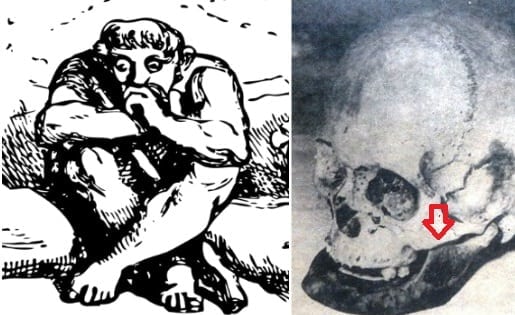
“There were giants in Samal in those days..”
This was the story told in whispers and passed on from one generation to the next about the alleged giant race—the Dinagats–that once populated the small tadpole-shaped island of Samal across the Davao Gulf, over 200 years ago.
Also Read: Atlantis of the Philippines? Exploring the Mysterious “Lost Island” of Mindanao
All the more was this given credence, when, in September of 1967, a team of student anthropologists from Davao’s University of Mindanao, led by Dr. Jose A. Samson, embarked on an expedition to the rocky Punta Libod promontory jutting out to the sea.
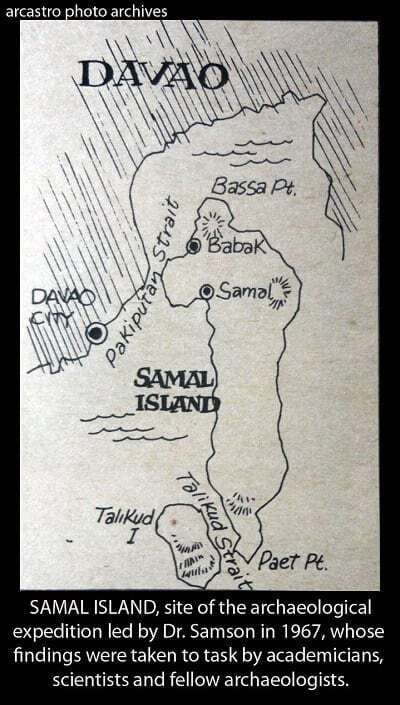
It was hardly explored by the people of Tagobo, the nearest sitio just a kilometer away, for they believe that the spirits of the dead resided there, and they were not to be disturbed.
True enough, in two small caves found at Punta Libod located 18 feet from the sea level, Dr. Samson and his team found centuries-old coffins containing various artifacts and remains in various stages of preservation.
Also Read: 15 Most Intense Archaeological Discoveries in Philippine History
There were highly eroded bones of normal-sized Samal natives who died over 120 years ago. Dr. Samson surmised that the Samals may have taken over these burial caves from the Dinagats after the race died out.
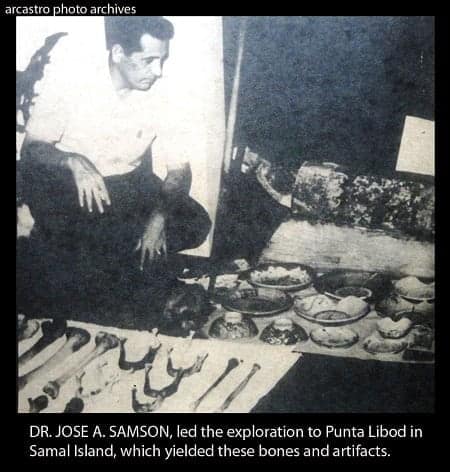
Among the assorted bones and dug-up artifacts was a jaw bone of a relatively big-sized human being and the facial portion of the skull that belonged to different individuals. Both had peculiar characteristics.
The jawbone, asserted Dr. Samson, was definitely bigger than that of any large-sized Filipino.
Also Read: The Hanging Coffins of Sagada
The frontal bone elevation of the skull measured 9.6 cm. from the suture of the bridge of the nose to the frontal skull curvature. “As compared to the 7-8 cm. elevation length of the common Filipino skull,” Dr. Samson noted, “this frontal height is much too great.”
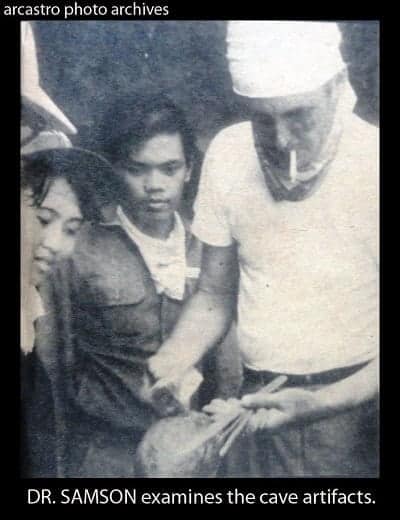
However, the frontal bone of the skull measures only 11.5 cm.–too short to the average Filipino’s 13-14 cm. Based on Manouvrier’s skull standards, Dr. Samson drew a picture of a man who owned the skull to have “an abnormally long and radically flat forehead.”
Reconstructing the height of the individuals who owned the bones with the use of the Pearson height estimation formula, Dr. Samson concluded that the extinct Dinagats were from “five feet four to five feet seven inches in height” (the average height of British men in the 1700s was 5’6”).
These findings seemed to back up the claim of old folks in the island that, once upon a time, their place was “inhabited by a race of big people whose characteristics and features were different from the Samals.”
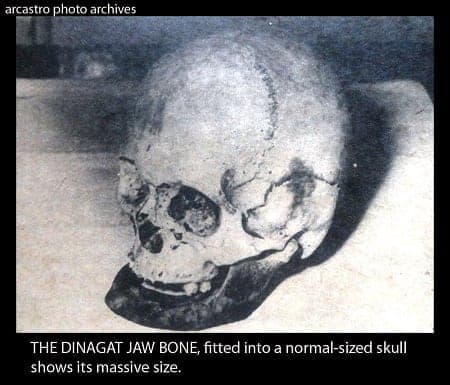
The news of the discovery of “Samal Giants” created a widespread buzz in the academic and scientific circles.
The first to voice his dissension was a colleague of Dr. Samson himself, Prof. Antonio Dagdag of the University of Mindanao, who claimed that no such people existed in the islands—that the so-called “Dinagats” could be the same “Dumagats” living in Bukidnon, perhaps driven out from Samal by Muslims.
Other anthropologists also noted that there was a lack of adequate reliable measurements of “Filipino” skulls–particularly on the range of the variation of the size of the lower jaw–so it would be unwise for Dr. Samson to say that the jaw bone was “definitely bigger than any large-size Filipinos.”
This applies to the “frontal skull curvature” measurements as well, which was a new way of comparing skulls. No such records of measurements are available for either “Filipino” or “Samal” skulls. Furthermore, “Filipino” is a national category, not a racial category.
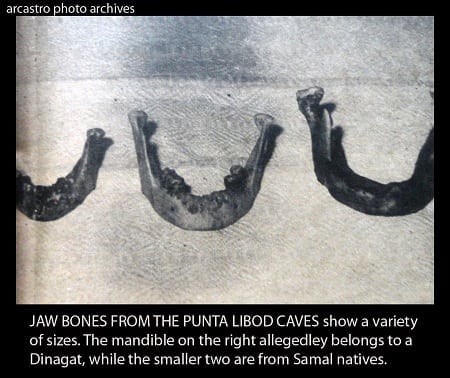
Dr. Samson too did not explain the significance of the computed statures of 5’4” to 5’7”–a range still common among living Philippine populations.
Moreover, Pearson’s formula used by the doctor was derived from European white populations, and therefore, should be cautiously applied to non-European specimens. Besides, there are other more accurate formulas for determining heights, for example using leg bones.
The photographic evidence was also questioned by many anthropologists. The massive Dinagat jaw bone was not convincing and could have come from an extremely aged individual, or one who has lost many teeth.
It was also possible that a larger male jaw may have been paired with a female “normal adult-sized skull.” As to the variances in the sizes of the mandibles (lower jaw) presented in the picture, this could be attributed to sexual and age dimorphism.
Also Read: An Ultimate Guide To Philippine Mythology’s Legendary Deities
Finally, “big people” in oral folk history are very common—not just in the Philippines, but also in other foreign lands. Confirmatory information relative to archaeology should have been extracted from folk stories of people as part of the corroborative data.
The mystery of the Samal Giants seemed to have been solved after the premises and findings of Dr. Samson were debunked, its reputation as an “island of the giants” now just a tall tale–and a part of its mythology.
ong>About the Author: Alex R. Castro is a retired advertising executive and is now a consultant and museum curator of the Center for Kapampangan Studies of Holy Angel University, Angeles City. He is the author of 2 local history books: “Scenes from a Bordertown & Other Views” and “Aro, Katimyas Da! A Memory Album of Titled Kapampangan Beauties 1908-2012”, a National Book Award finalist. He is a 2014 Most Outstanding Kapampangan Awardee in the field of Arts. For comments on this article, contact him at [email protected]
References
Ranido, Florencio A. Relics of a Lost Tribe, The Sunday Times Magazine, 14 July 1968,p. 22-23.
Bailen, J.B., Evangelsita, A.E., Francisco, J.R. The ‘Samal Giant” Story: Cutting it Down to Size. The Sunday Times magazine, 1 September 1968,pp. 26-28.
FilipiKnow
FilipiKnow strives to ensure each article published on this website is as accurate and reliable as possible. We invite you, our reader, to take part in our mission to provide free, high-quality information for every Juan. If you think this article needs improvement, or if you have suggestions on how we can better achieve our goals, let us know by sending a message to admin at filipiknow dot net
Copyright Notice
All materials contained on this site are protected by the Republic of the Philippines copyright law and may not be reproduced, distributed, transmitted, displayed, published, or broadcast without the prior written permission of filipiknow.net or in the case of third party materials, the owner of that content. You may not alter or remove any trademark, copyright, or other notice from copies of the content. Be warned that we have already reported and helped terminate several websites and YouTube channels for blatantly stealing our content. If you wish to use filipiknow.net content for commercial purposes, such as for content syndication, etc., please contact us at legal(at)filipiknow(dot)net
